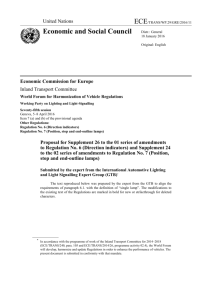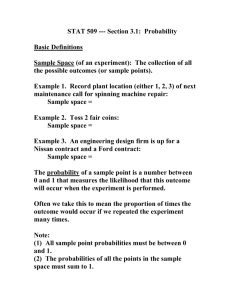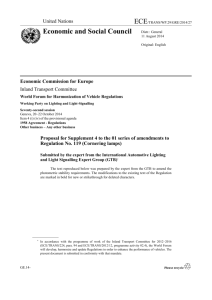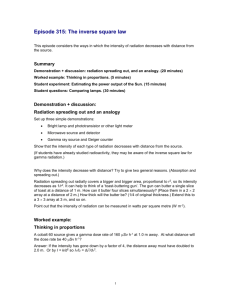Daytime running lamps
advertisement
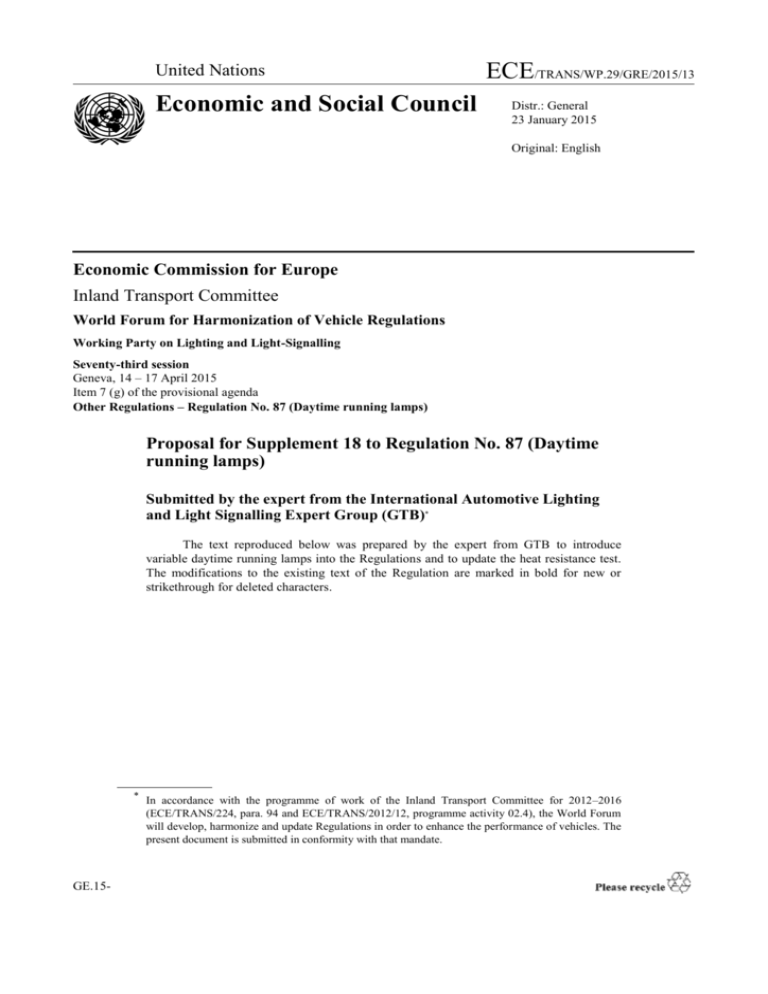
United Nations Economic and Social Council ECE/TRANS/WP.29/GRE/2015/13 Distr.: General 23 January 2015 Original: English Economic Commission for Europe Inland Transport Committee World Forum for Harmonization of Vehicle Regulations Working Party on Lighting and Light-Signalling Seventy-third session Geneva, 14 – 17 April 2015 Item 7 (g) of the provisional agenda Other Regulations – Regulation No. 87 (Daytime running lamps) Proposal for Supplement 18 to Regulation No. 87 (Daytime running lamps) Submitted by the expert from the International Automotive Lighting and Light Signalling Expert Group (GTB)* The text reproduced below was prepared by the expert from GTB to introduce variable daytime running lamps into the Regulations and to update the heat resistance test. The modifications to the existing text of the Regulation are marked in bold for new or strikethrough for deleted characters. * GE.15- In accordance with the programme of work of the Inland Transport Committee for 2012–2016 (ECE/TRANS/224, para. 94 and ECE/TRANS/2012/12, programme activity 02.4), the World Forum will develop, harmonize and update Regulations in order to enhance the performance of vehicles. The present document is submitted in conformity with that mandate. ECE/TRANS/WP.29/GRE/2015/13 I. Proposal Paragraph 2.3., amend to read: "2.3. "Daytime running lamps of different types" means lamps or interdependent lamp systems which differ in such essential respects as: (a) The trade name or mark; (b) The characteristics of the optical system, (levels of intensity, light distribution angles, category of light source, light source module, etc.); (c) The variable intensity control, if any. A change of the colour of the light source or the colour of any filter does not constitute a change of type." Paragraph 3.1., amend to read: "3.1. The application for approval shall be transmitted by the holder of the trade name or mark or his duly accredited representative. It shall specify: 3.1.1. Whether the daytime running lamp produces steady luminous intensity (category RL) or variable luminous intensity (category RLV). 3.1.2. At the choice of the applicant, it will specify that the daytime running lamp may be installed on the vehicle with different inclinations of the reference axis in respect to the vehicle reference planes and to the ground or rotate around its reference axis; these different conditions of installation shall be indicated in the communication form. All the interdependent lamps of an interdependent lamp system shall be submitted for type approval by the same applicant." Introduce a new paragraph 3.2.3., to read: "3.2.3. In the case of a daytime running lamp with variable luminous intensity, (a) a concise description of the variable intensity control; (b) the variable intensity control or a generator providing the same signals." Renumber paragraph 3.2.3., to become paragraph 3.2.4. Paragraph 4.3., amend to read: "4.3. In the case of daytime running lamps with an electronic light source control gear or a variable intensity control and/or non-replaceable light sources and/or light source module(s), bear the marking of the rated voltage or range of voltage and rated maximum wattage." Paragraph 4.6., amend to read: "4.6. Lamps operating at voltages other than the nominal rated voltages of 6 V, 12 V or 24 V respectively, by the application of an electronic light source control gear or a variable intensity control being not part of the lamp, must also bear a marking denoting the rated secondary design voltage." Paragraph 4.7., amend to read: 2 ECE/TRANS/WP.29/GRE/2015/13 "4.7. An electronic light source control gear or a variable intensity control being part of the lamp but not included into the lamp body shall bear the name of the manufacturer and its identification number." Paragraph 5.2.2., amend to read: 5.2.2. The additional symbol "RL" for a daytime running lamp with steady luminous intensity or the additional symbol "RLV" for a daytime running lamp with variable luminous intensity, and" Paragraph 7, amend to read: "7. Intensity of light and apparent surface 7.1. Daytime running lamps with steady luminous intensity (category: RL) 7.1.1. The luminous intensity of the light emitted by each category RL daytime running lamp shall not be less than 400 cd in the axis of reference. 7.1.2. Outside the reference axis and within the angular fields defined in the arrangement diagram in Annex 6 to this Regulation, the intensity of the light emitted by each category RL daytime running lamp shall: 7.1.2.1. In each direction corresponding to the points in the table of standard light distribution reproduced in Annex 3 to this Regulation, be not less than the minimum specified in paragraph 7.1. above, multiplied by the percentage specified in the said table of the direction in question, and 7.1.2.2. Not exceed 1,200 cd in any direction the category RL daytime running lamp is visible. 7.1.3. Moreover, throughout the field defined in the diagram in Annex 6, the intensity of the light emitted must not be less than 1.0 cd. 7.1.4. The area of the apparent surface in the direction of the axis of reference of the daytime running lamp shall be not less than 25 cm² and not more than 200 cm². 7.2. Daytime running lamps with variable luminous intensity (category: RLV) 7.2.1. Daytime running lamps of category RLV shall have at least two levels of intensity. The operating conditions of the different levels are specified in R48, annex 13. 7.2.1.1. Luminous intensities in case of low-level activation shall not be less than 200 cd in the axis of reference and shall not exceed 800 cd in any direction the lamp is visible. 7.2.1.2. Luminous intensities in case of high-level activation shall not be less than 800 cd in the axis of reference and shall not exceed 2,000 cd in any direction the lamp is visible. 7.2.1.3. Luminous intensities in case of intermediate-level activation shall not be less than 400 cd in the axis of reference and shall not exceed 1,200 cd in any direction the lamp is visible. 7.2.2. Outside the reference axis and within the angular fields defined in the arrangement diagram in Annex 6 to this Regulation, the intensity of the light emitted by each lamp within each level must: 3 ECE/TRANS/WP.29/GRE/2015/13 7.2.2.1. In each direction, corresponding to the points in the table of standard light distribution reproduced in Annex 3 to this Regulation, be not less than the minimum specified in paragraphs 7.2.1.1. to 7.2.1.3. above, multiplied by the percentage specified in said table of the direction in question; and 7.2.2.2. not exceed in any direction the related maximum value specified in paragraphs 7.2.1.1. to 7.2.1.3. above. 7.2.3. Moreover, throughout the field defined in the diagram in Annex 6, the intensity of the light emitted must not be less than 1.0 cd at each level of intensity. 7.2.4. The area of the apparent surface in the direction of the axis of reference of the lamp shall be not less than 25 cm² and not more than 400 cm². 7.3. Light source failure 7.3.1. In the case of a daytime running lamp containing more than one light source, the daytime running lamp shall comply with the minimum intensity required and the maximum intensity shall not be exceeded. 7.3.2. In case of failure of any one light source in a single lamp containing more than one light source, one of the following provisions shall apply: 7.3.3. (a) The light intensity at the points of standard light distribution defined in Annex 3 to this Regulation shall be at least 80 per cent of the minimum intensity required; or (b) The light intensity in the axis of reference shall be at least 50 per cent of the minimum intensity required, provided that a note in the communication form states that the lamp is only for use on a vehicle fitted with an operating tell-tale. A group of light sources, wired so that the failure of any one of them causes all of them to stop emitting light, shall be considered to be one light source." Paragraph 7.4., delete. Paragraph 8., delete. Paragraph 9., renumber to become paragraph 8. and amend to read: "9.8. Colour of light The colour of the light shall be white. It shall be measured under the conditions as prescribed in paragraph 9. below." Paragraph 10., renumber to become paragraph 9. and amend to read: 10.9. Test procedure 10.9.1. All measurements, photometric and colorimetric, when not supplied by an electronic light source control gear or a variable intensity control, shall be carried out with an uncoloured or coloured standard light source of the category prescribed for the daytime running lamp, supplied with the voltage: (a) 4 In the case of filament lamps, that is necessary to produce the reference luminous flux required for that category of filament lamp; ECE/TRANS/WP.29/GRE/2015/13 (b) In the case of LED light sources of 6.75 V, 13.5 V or 28.0 V; the luminous flux value produced shall be corrected. The correction factor is the ratio between the objective luminous flux and the mean value of the luminous flux found at the voltage applied. 10.9.2. In the case of a system that uses an electronic light source control gear or a variable intensity control being part of the daytime running lamp 1, all measurements, photometric and colorimetric, shall be made applying at the input terminals of the lamp a voltage of 6.75 V, 13.5 V or 28.0 V respectively. 10.9.3. In the case of a system that uses an electronic light source control gear or a variable intensity control not being part of the daytime running lamp the voltage declared by the manufacturer shall be applied to the input terminals of the daytime running lamp. The test laboratory shall require from the manufacturer the light source control gear needed to supply the light source and the applicable functions. The voltage to be applied to the daytime running lamp shall be noted in the communication form in Annex 1 to this Regulation." 10.9.4. For any daytime running lamp except those equipped with filament lamps, the luminous intensities, measured after one minute and after 30 minutes of operation, shall comply with the minimum and maximum requirements. The luminous intensity distribution after one minute of operation can be calculated from the luminous intensity distribution after 30 minutes of operation by applying at each test point the ratio of luminous intensities measured at HV after one minute and after 30 minutes of operation. However, in the case of light sources operated by a variable intensity control photometric measurements shall be performed according to the applicant`s description. 10.9.5. The limits of the apparent surface in the direction of the reference axis of a light-signalling device shall be determined. The test laboratory shall require from the manufacturer the light source control gear or a variable intensity control needed to supply the light source. 1 9.6. The voltage to be applied to the daytime running lamp shall be noted in the communication form in Annex 1 of this Regulation. 9.7. For any daytime running lamp except those equipped with filament lamps, the luminous intensities, measured after one minute and after 30 minutes of operation, shall comply with the minimum and maximum requirements. The luminous intensity distribution after one minute of operation can be calculated from the luminous intensity distribution after 30 minutes of operation by applying at each test point the ratio of luminous intensities measured at HV after one minute and after 30 minutes of operation. For the purpose of this Regulation, "being part of the lamp" means to be physically included in the lamp body or to be external, separated or not, from the lamp body but supplied by the lamp manufacturer as part of the lamp system. 5 ECE/TRANS/WP.29/GRE/2015/13 9.8. The limits of the apparent surface in the direction of the reference axis of a light-signalling device shall be determined." Paragraph 11. and its subparagraphs, renumber to become paragraph 10. and its subparagraphs. New paragraph 10.2 (former paragraph 11.2.), amend to read: 11.10.2. Where only the maximum power is specified, the test shall be carried out by regulating the voltage to obtain a power equal to 90 per cent of the specified power. The specified average or maximum power referred to above shall in all cases be chosen from the voltage range of 6, 12 or 24 V at which it reaches the highest value; for lamps equipped with non-replaceable light sources (filament lamps and other) the test conditions set in paragraph 10.2. of this Regulation shall be applied. Where no maximum power is specified, the test shall be carried out with the highest wattage light source that can be used." Paragraph 12. and its subparagraphs, renumber to become paragraph 11. and its subparagraphs. Paragraph 13., renumber to become paragraph 12. and amend to read:. "13.12. Conformity of production The conformity of production procedures shall comply with those set out in the Agreement, Appendix 2 (E/ECE/324-E/ECE/TRANS/505/Rev.2), with the following requirements: 13.12.1. Daytime running lamps approved under this Regulation shall be so manufactured as to conform to the type approved by meeting the requirements set forth in paragraphs 6., 7. and 8. and 9. above. 13.12.2. The minimum requirements for conformity of production control procedures set forth in Annex 4 to this Regulation shall be complied with. 13.12.3. The minimum requirements for sampling by an inspector set forth in Annex 5 to this Regulation shall be complied with. 13.12.4. The Type Approval Authority which has granted type approval may at any time verify the conformity control methods applied in each production facility. The normal frequency of these verifications shall be once every two years." Paragraph 14. and its subparagraphs, renumber to become paragraph 13. and its subparagraphs. Paragraph 15. and its subparagraphs, renumber to become paragraph 14. and its subparagraphs. Paragraph 16. and its subparagraphs, renumber to become paragraph 15. and its subparagraphs. Annex 1, item 9., amend to read: "9. Concise description: By category of lamp: ..................................................................................................... Number, category and kind of light source(s):2 ........................................................... Voltage and wattage: ................................................................................................... 6 ECE/TRANS/WP.29/GRE/2015/13 Application of an electronic light source control gear/variable intensity control: (a) Being part of the lamp: Yes/No2 (b) Being not part of the lamp: Yes/No2 Input voltage supplied by an electronic light source control gear/variable intensity control: ........................................................................................................................ Electronic light source control gear/variable intensity control manufacturer and identification number (when the light source control gear is part of the lamp but is not included into the lamp body): ................................................................................. Only for use in a vehicle fitted with an operating tell-tale to indicate light source failure: Yes/No2 ............................................................................................. " Annex 2., figure 1 and its corresponding text, amend to read: "Annex 2 Examples of arrangements of the approval mark Figure 1 V The daytime running lamp with variable luminous intensity bearing the approval mark shown above has been approved in the Netherlands (E 4) under number 001015. The approval number indicates that the approval was granted according to the requirements of this Regulation in its original (unamended) form. Note: The approval number and the additional symbol must be placed close to the circle and either above or below the "E" or to the left or right of that letter. The digits of the approval number must be on the same side of the "E" and face the same direction. The use of roman numerals as approval numbers should be avoided so as to prevent any confusion with other symbols." 7 ECE/TRANS/WP.29/GRE/2015/13 Figure 1a The lamp bearing the approval mark shown above has been approved in the Netherlands (E 4) under number 001015 as a part of an interdependent lamp system composing a daytime running lamp. The approval number indicates that the approval was granted according to the requirements of this Regulation in its original (un-amended) form." Annex 3., paragraph 5.2., amend to read: "5.2. Within the field of light distribution of paragraph 5 3. above schematically shown as a grid, the light pattern should be substantially uniform, i.e. in so far as the light intensity in each direction of a part of the field formed by the gird grid lines shall meet at least the lowest minimum value being shown on the gird grid lines surrounding the questioned direction as a percentage." Annex 4., paragraph 1.2.2., amend to read: "1.2.2. If, in the case of a lamp equipped with a replaceable light sources and if results of the test described above do not meet the requirements, tests on lamps shall be repeated using another standard light source." II. Justification (a) Introduction of the Variable Intensity Daytime Running Lamp (this proposal accompanies the associated proposal for amendments to Regulation No. 48) 1. The current provisions for DRLs are based upon one level of performance between 400 – 1,200 cd for all ambient conditions. However, it has been shown that under certain ambient light conditions this fixed level can either be too bright (at dusk) or too dim (at southern latitudes on bright sunny days). 2. An optional category of DRL is proposed that permits variation according to the ambient light levels. The variable intensity level commences at 200 cd to avoid any glare annoyance in dusk and dawn traffic conditions and also prevent giving the impression to the driver that they are already driving with the normal head lighting ON, as can presently occur due to some visible illumination of the road surface or by reflections on the preceding car. 3. The new limit of 2,000 cd is higher than the current maximum of 1,200 cd but, according to the proposed amendment, this higher limit cannot occur in dim ambient conditions because it is controlled by switching requirements to be introduced by the 8 ECE/TRANS/WP.29/GRE/2015/13 associated proposal to Regulation No. 48. For reference, the United States of America and Canada allow much higher maximum values for the intensities (3,800 to 7,000 cd) of devices used for DRL purposes. (b) Amendments to the heat resistance tests 4. The heat resistance test in Regulation No. 87 (currently paragraph 11) does not represent the state-of-the-art. The current requirements of the Regulation on Daytime Running Lamps, except those equipped with filament lamps, require that the photometric performance is verified after 1 minute and 30 minutes of operation. In the case the lamp is not stable, it will not meet the photometric requirements; therefore, it is not necessary to carry out the heat test on Daytime Running Lamps equipped with LEDs. 9
